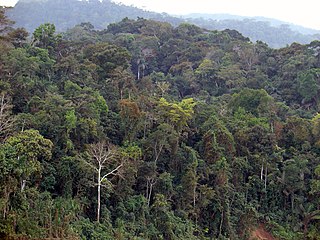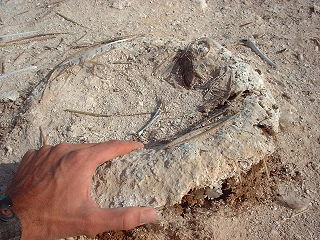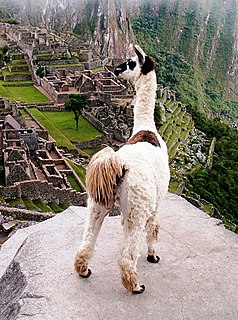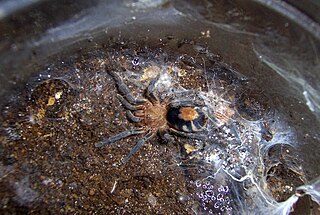
The Andes, Andes Mountains or Andean Mountains are the longest continental mountain range in the world, forming a continuous highland along the western edge of South America. The range is 6,999 km (4,349 mi) long, 200 to 700 km wide, and has an average height of about 4,000 m (13,123 ft). The Andes extend from north to south through seven South American countries: Venezuela, Colombia, Ecuador, Peru, Bolivia, Chile, and Argentina.

Peru, officially the Republic of Peru, is a country in western South America. It is bordered in the north by Ecuador and Colombia, in the east by Brazil, in the southeast by Bolivia, in the south by Chile, and in the south and west by the Pacific Ocean. Peru is a megadiverse country with habitats ranging from the arid plains of the Pacific coastal region in the west to the peaks of the Andes mountains extending from the north to the southeast of the country to the tropical Amazon Basin rainforest in the east with the Amazon river. Peru has a population of 34 million, and its capital and largest city is Lima. At 1.28 million km2, Peru is the 19th largest country in the world, and the third largest in South America.

Avicularia is a genus of the family Theraphosidae containing various species of tarantulas. The genus is native to tropical Central and South America. Each species in the genus has very distinguishable pink foot pads.

Peruvian Amazonia is the area of the Amazon rainforest included within the country of Peru, from east of the Andes to the borders with Ecuador, Colombia, Brazil and Bolivia. This region comprises 60% of the country and is marked by a large degree of biodiversity. Peru has the second-largest portion of the Amazon rainforest after the Brazilian Amazon.

Guano is the accumulated excrement of seabirds and bats. As a manure, guano is a highly effective fertilizer due to its exceptionally high content of nitrogen, phosphate, and potassium: key nutrients essential for plant growth. Guano was also, to a lesser extent, sought for the production of gunpowder and other explosive materials.

Tennis Europe was formed in Rome, Italy on 31 May 1975 by a group of 17 European national tennis federations as a regional governing body for the sport of tennis and under the auspices of the International Tennis Federation. It is the world's largest regional association of the sport's governing body, the International Tennis Federation, with 50 member states in 2015.

Tarantulas comprise a group of large and often hairy spiders of the family Theraphosidae. Currently, 1,010 species have been identified. The term "tarantula" is usually used to describe members of the family Theraphosidae, although many other members of the same infraorder (Mygalomorphae) are commonly referred to as "tarantulas" or "false tarantulas". Some of the more common species have become popular in the exotic pet trade. Many New World species kept as pets have setae known as urticating hairs that can cause irritation to the skin, and in extreme cases, cause damage to the eyes.
Neischnocolus is a genus of spiders in the family Theraphosidae. It was first described in 1925 by Petrunkevitch. The genus Ami was separately described in 2008, but was later discovered to be a junior synonym of Neischnocolus. Species are native to Central America and northern South America.

Pichu Pichu or Picchu Picchu is an inactive eroded volcano in the Andes of Peru. It is located in the Arequipa Region, Arequipa Province, on the border of Pocsi and Tarucani districts. Pichu Pichu reaches a height of 5,664 metres (18,583 ft) and is part of Salinas and Aguada Blanca National Reserve.

Peru has some of the greatest biodiversity in the world. It belongs to the select group of mega diverse countries because of the presence of the Andes, Amazon rainforest, and the Pacific Ocean. It has the fourth-most tropical forests of any country and the ninth-most forest area.

Cyriocosmus is a genus of tarantulas that was first described by Eugène Louis Simon in 1903.

Manduca lamasi is a moth of the family Sphingidae. It is known from Peru.

Luwu Regency is a regency of South Sulawesi Province, Indonesia. The administrative capital now lies at Belopa, since the former capital (Palopo) became an independent municipality (city) in 2006, at which date the then existing Luwu Regency was split into four entities - Palopo city, North Luwu Regency, East Luwu Regency, and the residual Luwu Regency. The regency now covers 2,909.08 km2 and had a population of 287,472 at the 2010 Census and 365,608 at the 2020 Census.
Erbessa lamasi is a moth of the family Notodontidae first described by James S. Miller in 2008. It is found in south-eastern Peru.

Parides aeneas is a species of butterfly in the family Papilionidae. It is found in the Neotropical realm.
Bistriopelma is a genus of spider, being a theraphosine theraphosid (tarantula). It has two species as of February 2016, both of which are found in Peru.
Bistriopelma matuskai is a species of tarantula, in the theraphosinae subfamily, which is only known from Peru.
Magnacarina is a genus of spiders in the family Theraphosidae. It was first described in 2016 by Mendoza, Locht, Kaderka, Medina & Pérez-Miles. As of 2017, it contains 4 species.
Rick C. West is a Canadian arachnologist with a main expertise toward tarantula spiders. West was born in Victoria, British Columbia. He has been interested in spiders since childhood, and collected his first tarantula, Aphonopelma eutylenum at the age of 13. He worked primarily as a Chief Constable for a local Animal Humane Society, but also have been involved with the collecting, breeding, rearing and photography of theraphosid spiders. West has traveled to over 27 countries to document and study them in their environment, has been a host, presenter and co-producer in several tarantula documentaries and has also described several new species.












